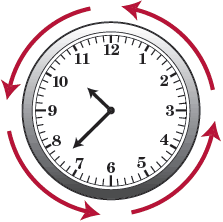Counterclockwise
The term counterclockwise describes the direction that is the opposite of the way the hands of a clock normally move.
Counterclockwise definition
Counterclockwise is defined as the direction opposite that in which the hands of a clock move.
Which way is counterclockwise
Looking at clock from the front or above, a counterclockwise direction means the hand of the clock moving left and around in a circular motion. It is the opposite direction of movement from a clockwise direction. Refer to the image below.

Both the definitions of counterclockwise and clockwise require that the position you are looking at the clock from is defined. This is because depending on where you are when looking at the clock, the direction of rotation is different. A clockwise rotation looking at the clock from the front or above would be counterclockwise if the same rotation were viewed from behind or below.
How is counterclockwise used
Counterclockwise is used in many real-life applications. One of the most common is when loosening some object like a screw, nut, bolt, faucet, and more. Also, in geometry, positive angle measures are measured in a counter-clockwise direction. If the measure of an angle proceeds in a clockwise direction, the measure of the angle is conventionally negative. The figure below shows a counterclockwise angle example and a clockwise angle example:

Did you know?
The traditional way that the hands on a clock rotate is due to how sundials, one of the devices used to tell time before the development of clocks, worked. The hands on a clock don't have to move in what is defined as a clockwise direction, and there have been clocks that were designed to have hands that moved in a counterclockwise direction.
